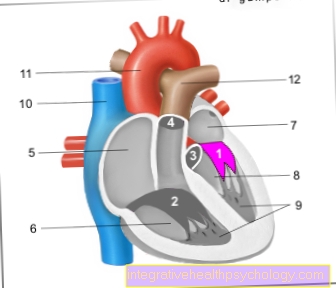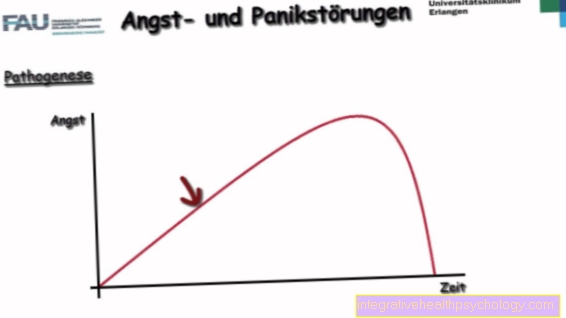Addison's disease
Synonyms in the broadest sense
- Adrenal insufficiency
- primary adrenal insufficiency
- Addison's disease
- Addison syndrome
English: Addison's syndrome, Addison's disease, adrenal insufficiency
Definition and introduction
Addison's disease is a dysfunction of the adrenal cortex. It is also known as primary adrenal insufficiency and is more of a rare condition.
If Addison's disease remains untreated, however, it is fatal and is therefore of clear clinical relevance. In most cases, autoimmune processes destroy the cells of the adrenal cortex.
Addison's disease can be symptom-free for years and only show up in special situations. The spectrum of symptoms of Addison's disease is wide. Thanks to modern drugs, nowadays with good training and willingness to cooperate (Compliance) the quality of life is high and the life expectancy normal.

frequency
Of a Addison's disease are Women more often affected than men.
The mean age of onset is around 40 years. However, there is a clear spread.
With a prevalence of around 1-5 sufferers per 100,000 For residents, primary adrenal insufficiency is a rather rare disease.
Classification of Addison's disease
The classification of the Addison's disease takes place on the one hand after Course of the disease:
- slowly progressing
- acute with rapid cessation of the functions of the adrenal cortex
On the other hand, the classification is based on the causes. The most common triggering factors are therefore:
- Autoimmune processes (70-80%)
- Infections
- Heart attacks
- Tumors
- other
Causes and origins
As Cause of Addison's disease you can find one from immune system the body's defense reaction against the body's own cells. These autoantibodies are specifically against the cells of the Adrenal cortex directed. A defense reaction follows and the cells are destroyed.
This form of primary adrenal insufficiency, in which antibodies generated by the body itself and directed against the body's own structures cause destruction of the adrenal cortex, is with 70-80 % the most common form of primary adrenal insufficiency.
Primary adrenal insufficiency can also be caused by:
- Tumors and their Daughter ulcers (metastases),
- Heart attacks (Waterhouse-Friderichsen Syndorm)
and - Infections (e.g. tuberculosis, HIV / AIDS, Cytomegaly virus)
to be triggered.
Other causes of Addison's disease are:
- Sarcoid
- Amyloidosis (pathological deposit of proteins between the cells)
- Hemochromatosis (Iron storage disease)
- Adrenoleucodystrophy (Hereditary disease that manifests itself in childhood and is characterized by rapid neurological decay)
- or Bleeding
or - certain Medication.
stress
Stress normally causes cortisol to be released in healthy people, which is why it is often referred to as the stress hormone. With an existing adrenal insufficiency, the body is no longer able to maintain cortisol production, let alone increase it. The body goes into a state of hypocortisolism - that is, a cortisol level that is too low. Especially in people with undiagnosed adrenal insufficiency, stress and the associated hypocortisolism can lead to the discovery of the disease or, in the worst case, to an Addison crisis. It is a life-threatening condition with various symptoms such as clouding of consciousness, hypoglycaemia, fever, vomiting, etc., which requires immediate medical emergency treatment.
Hashimoto's thyroiditis
Hashimoto's thyroiditis is a chronic inflammation of the thyroid gland caused by autoimmune antibodies. The body's own cells are directed against the thyroid gland due to unexplained causes and lead to cell death in the course of the disease. Those affected then show an underactive thyroid. Adrenal insufficiency is often associated with other diseases, including Hashimoto's thyroiditis. In this context, doctors also like to speak of a pluriglandular syndrome, i.e. a disorder of several organs with glandular function that serve to produce hormones. The exact cause is still unclear. A genetic component is suspected, but has not yet been clearly proven by scientific studies. Regular controls of the organs are important for Addison's disease sufferers in order to quickly identify any loss of function and to be able to treat it properly.
Symptoms
Since the function of the adrenal glands is disturbed in Addison's disease, the production of various hormones is impaired. The typical symptoms become noticeable when around 90% of the adrenal cortex has already been destroyed. Cortisol, aldosterone and the sex hormones can no longer be produced in sufficient quantities. In contrast, the concentration of ACTH, a hormone of the pituitary gland in the brain, which stimulates hormone production in the adrenal glands, is significantly increased.
The lack of aldosterone as a mineral corticoid leads to a drop in blood pressure due to the loss of sodium and water loss (dehydration) (Hypotension). In addition, there is an increase in potassium in the blood. In those affected, the lack of salt manifests itself in an increased hunger for salty foods.
Read more about the Consequences of electrolyte imbalances.
The lack of cortisol as a stress hormone leads to a feeling of weakness, nausea and weight loss. The blood sugar level also drops (Hypoglycemia). In addition, there is excessive tanning of the skin (Hyperpigmentation), which is triggered by the increased release of ACTH.
Since the production of sex hormones is also impaired, women often have a lack of armpit and pubic hair and men have problems with potency.
In infants, a loss of function of the adrenal glands becomes noticeable as a growth stoppage.
In an extreme emergency, it can also lead to a complete hormonal imbalance, the so-called Addison's crisis. It can lead to a life-threatening metabolic derailment and requires immediate intensive medical treatment.
Read a lot more information on this topic at: Symptoms of Addison's disease
Hyperpigmentation
Hyperpigmentation of the skin is found in primary adrenal insufficiency. The reason for this is the increased amount of ACTH. This arises from the preliminary stage Proopiomelanocortin or POMC for short. The POMC also represents the preliminary stage of a hormone that affects the melanocytes in the skin. The melanocytes are skin cells that are responsible for the coloring or the color of the skin. Accordingly, an increased release of POMC or ACTH leads to a stronger stimulation of the melanocytes and then also to hyperpigmentation or "darkening" of the skin.
diagnosis
When diagnosing Addison's disease, it is very important to differentiate the disease from secondary adrenal insufficiency. The difference is that in Addison's disease the adrenal glands are damaged and therefore too few hormones are produced, whereas in the secondary disorder these are intact, but not sufficiently stimulated to produce hormones.
If Addison's disease is suspected, blood tests will be done to check hormone levels. If there is a lack of sodium and an increased concentration of potassium in the blood, a disorder of the adrenal glands can be assumed. In addition to the usual blood parameters, the amount of cortisol in the blood and the amount of ACTH are mainly determined.
ACTH is released by the pituitary gland in the brain and stimulates the adrenal glands to produce hormones. If the cortisol level is decreased, although there is enough or even too much ACTH in the blood, this indicates Addison's disease.
A so-called ACTH stimulation test can also be carried out. ACTH is injected intravenously, which would trigger increased cortisol production in healthy people with well-functioning adrenal glands. However, this is not the case with Addison's disease due to the damaged adrenal glands.
Find out all about the topic here: ACTH.
blood values
With adrenal insufficiency, the cortisol levels in the blood are low. The cortisol present in the blood cannot be used to determine the cause. If you want to know where the problem of the malfunction is, you have to determine the ACTH value. This is a hormone from the pituitary gland which naturally stimulates the adrenal gland to produce cortisol. Based on the ACTH value, it is then possible to find out whether the problem is in the adrenal gland or the pituitary gland, i.e. whether there is primary or secondary adrenal insufficiency.
In primary insufficiency, the adrenal gland no longer works properly, but the pituitary gland continues to try to stimulate it by releasing ACTH. Due to this, the ACTH is available in increased quantities. Furthermore, the values of aldosterone and DHEAS are determined, which are also hormones that are produced in the adrenal gland.
On the other hand, if the disorder is in the pituitary gland, the ACTH value is lowered. The pituitary gland can no longer perform its function and the hormones it produces are barely detectable in the blood.
therapy
There at Addison's disease The adrenal glands are destroyed and cannot regenerate, this disease can Not be cured. However, it can be treated well with lifelong therapy. It is necessary to take in the hormones that are no longer sufficiently produced by the adrenal glands (substitution). Usually both Glucocorticoids (Cortisol), as well as Mineral corticoids (Aldosterone) can be substituted. Since it is very important to take the correct dose of hormones, the exact amount of hormones to be taken and regular follow-ups by the attending physician are necessary.
In healthy people, cortisol is most produced in the morning and released into the blood. The hormone replacement therapy is adapted to this rhythm and the greatest amount of Cortisol substitutes is taken in the morning. In most cases, hydrocortisone is used for this in the form of tablets. In the case of existing stress, such as an infection or an operation, the amount must be temporarily increased. If this does not happen, it can be life threatening in the worst case scenario Addison crisis with circulatory failure.
Fludrocortisone is mostly used as a substitute for aldosterone. Just like aldosterone in normal cases, this ensures that blood pressure is regulated.
How to Eat if you have Addison's Disease?
A healthy diet with a low proportion of quickly digestible sugar or carbohydrates is recommended for Addison's disease. Carbohydrates from white sugar or fructose cause blood sugar to rise quickly, and the body then has to release the messenger substance insulin. With large amounts of sweets, a large amount of insulin is released, which can then lead to a very rapid drop in sugar. In such cases, the body actually reacts by releasing cortisol in order to activate stored sugar reserves and thus counteract the falling levels. Due to the insufficiency of the adrenal gland, however, it can only react to a limited extent and is also heavily stressed.
Because of this, it is advisable to eat carbohydrates that cause a slow rise in blood sugar, such as brown rice or whole wheat pasta. In addition to the “good” carbohydrates, vegetables, omega 3 fatty acids and proteins such as those from fish and lean meat are of course among the foods that should be at the top of the menu for Addison's disease.
Addison crisis
An Addison's crisis occurs when the body needs more cortisol than it has available in the situation. Mostly this is the case in stressful situations. These include heavy physical stress, but also febrile infections, gastrointestinal infections or operations. Strong psychological stress, trauma or the sudden discontinuation of cortisol therapy can also lead to such a crisis. An adrenal infarction also results in a loss of function of the adrenal glands and a hormone deficiency.
The Addison's crisis is an acutely life-threatening situation in which the body is unable to respond appropriately to a stressful situation, so that serious circulatory disorders occur, which can lead to a coma. Due to the lack of the hormones produced by the adrenal glands, regulation of blood pressure is limited. The body loses salts and water due to the hormone deficiency, which leads to a drop in blood pressure. Without rapid therapy with cortisol, this can lead to a state of shock that leads to a coma or, in the worst case, can be fatal.
The crisis manifests itself through nausea, vomiting, diarrhea, fever, confusion, hypoglycaemia and the drop in blood pressure leads to palpitations.
The Addison's crisis is often the reason why Addison's disease is suspected.
Secondary adrenal insufficiency
In secondary adrenal insufficiency, there is a disorder of the so-called pituitary gland. This is part of the human brain and has a stimulating effect on the adrenal gland by releasing certain hormones. These hormones naturally include the messenger substance ACTH (adrenocorticotropic hormone), which is formed in the adenohypophysis or pituitary gland and, after being released, induces cortisol production in the adrenal gland. Sometimes the pituitary gland does not work properly and then produces insufficient amounts of ACTH. The cause of the malfunction can be a tumor, for example. Due to the disrupted production, the messenger substances cannot work at their destination and the adrenal cortex has no drive to produce cortisol. Those affected then develop what is known as hypocortisolism, i.e. an insufficient amount of cortisol in the blood or body circulation.
Find out all about the topic here: secondary adrenal insufficiency.
Tertiary adrenal insufficiency
The external supply of cortisol, for example in the form of tablets for the treatment of various diseases, can cause adrenal insufficiency. Occasionally, tertiary adrenal insufficiency is also used here. The pituitary gland slows down its production of ACTH due to the increased amount of cortisol supplied from outside. Due to the lack of a stimulating effect of the messenger substance ACTH on the adrenal gland, it reacts by stopping its production of cortisol.
Learn more about the causes, symptoms and treatment options for the tertiary adrenal insufficiency.
anatomy
The Adrenal gland consists of two functionally different parts. The Adrenal cortex Hormones and the Adrenal medulla catecholamines (Adrenaline and noradrenaline).
At the Addison's disease only the bark is affected. Histologically, three layers can be seen in the adrenal cortex. The outer layer is called the zona glomerulosa. It is responsible for the production of mineral corticoids (e.g. aldosterone). The middle layer is the zona fasciculata and forms Glucocorticoids (e.g. Cortisol). In the innermost layer, zona reticularis, mainly the male sex hormones / androgens produced.
The adrenal glands are functionally independent of the Kidneys. They are located at the upper pole of the kidneys, practically sitting on them.
You can find out more about the structure and function under our topic: Adrenal gland.
physiology
To the disease of the Addison's disease to understand you need to understand the function of the Adrenal gland Understand produced hormones:
In the following you will learn more about the following three hormone groups:
- Mineralocorticoids
- Glucocorticoids
- Androgens
Mineral corticoids
Mineralocorticoids belong to the class of steroid hormones. Their job is to regulate the electrolyte and water balance.
The best-known representative is aldosterone, which arises from cholesterol.
It is also known as the thirst hormone. After it has been released from the zona glomerulosa of the adrenal cortex, it reaches the kidneys, where it causes the sodium reabsorption of the filtered primary urine in the tubule system. At the same time, it ensures the secretion of potassium and protons.
Since chloride and thus osmotically water are reabsorbed in addition to sodium, it increases blood volume and thus blood pressure. Finally, it is also responsible for the reabsorption of sodium and water in the gastrointestinal tract.
The effect takes place via the so-called renin-angiotensin-aldosterone system (RAAS). Release impulses are changes in blood pressure and osmolarity (changes in electrolytes in the blood).
Glucocorticoids
The glucocorticoids formed in the zona fasciculata (and partly also in the zona reticularis) also belong to the steroid hormones.
Their job is to provide energy in stressful situations. The most prominent representative is cortisol, which is transported in the blood mainly bound to proteins (transcortin and albumin).
Androgens
Androgens are sex hormones and cause, among other things, the development of the secondary sexual characteristics.
In men, androgens are mainly produced in the testicles. Therefore, the elimination of androgen production in men with Addison's disease has little or no effect. Women are therefore particularly affected. In women, androgens are the precursors of estrogens (female sex hormones).
Control loop and control of the release
The adrenal cortex hormones are released through a control circuit with negative feedback. A substance called ACTH (adrenocorticotropic hormone) is formed in the brain (more precisely the pituitary gland). This substance reaches the adrenal cortex via the bloodstream and causes the hormones to be released there. The release of ACTH from the pituitary gland is in turn regulated by a substance called CRH (corticotropin-releasing hormone). CRH is also produced in the brain (hypothalamus).
The distribution is made episodically. Glucocorticoids peak between 6 a.m. and 9 a.m. and a minimum around midnight. Stress causes an increase in the glucocorticoid level.
The control of the mineral corticoids is subject to the RAAS (Renin-Angiotensin-Aldosteron-System).
If the dysfunction affects the adrenal glands themselves, this is called primary. The secondary form relates to the release of ACTH, the tertiary form to the CTH secretion.






.jpg)






















